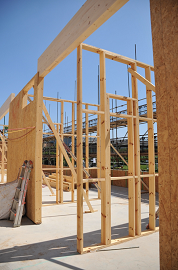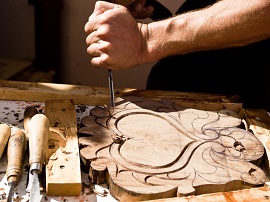Hardwood
Contents |
Introduction
Hardwoods are one of the most common types of wood used in manufacturing; everything from oak furniture to a mahogany mantelpiece are constructed with the hardwood. But what makes hardwood so special, and why is it different to traditional softwoods?
What are hardwoods?
Hardwoods are types of wood that come from deciduous trees – trees where their leaves fall every autumn. Some of the most common types of hardwood trees include oak, mahogany, ash, beech, and birch.
One reason hardwoods are known as hardwoods is because they tend to grow a lot more slowly than other types of trees, which results in the trunk, bark, and branches becoming denser, which can be a great benefit for carpenters and people that use wood on a regular basis.
Because of the increased density of the tree, the wood is more 'heavy duty' than its soft counterparts, which is why it is typically used in furniture such as tables, chairs, chest drawers, and so on.
The difference between hardwoods and softwoods
Traditional hardwoods, such as oak, can show annual growth rings, meaning that carpenters and tree enthusiasts can determine how old certain types of wood are, and that can determine various important characteristics of the wood. For example, the more rings there are, the denser it will be, meaning that it is a much higher quality hardwood compared to one that has very few rings.
However, people tend to associate hardwoods with hardness, but this isn’t always the case. For example, balsa is a common hardwood but it is generally softer than softwoods.

|

|
| Softwood | Hardwood |
Applications of hardwoods
Hardwoods have a wide range of applications, being used for fuel, tools, furniture, flooring, barrels, and the manufacturing of charcoal. The important thing is that, because hardwoods take longer to develop, they are more expensive, which is why they aren’t used as much as softwoods in industries, such as construction.
Hardwoods also have a complex structure, meaning they can produce beautiful features on the wood itself. For example, if you cut a hardwood tree horizontally, you will notice the annual growth rings, but, if you cut a hardwood tree vertically, you will notice the lines that run along the wood that is formed from the xylem tubes; this is known as the grain.
Because of its complex nature, unusual structures can form easily within the wood, such as extra branches protruding out of the wood. When the wood is cut, round ovals of darker wood can be seen, which are known as knots.
However, knots can actually weaken the structure of the wood itself, so it is important to make sure that you use wood with little knots for uses that require wood’s strength. For furniture items, strength isn’t a necessity, because people tend to focus more on the aesthetics of the wood, and it can definitely be said that hardwood with knots looks more aesthetically pleasing than plain hardwood.
--G&S Specialist Timber 09:11, 16 Feb 2017 (BST)
Related articles on Designing Buildings Wiki
- 11 things you didn't know about wood.
- Ancient Woodland.
- Bamboo flooring.
- Birch wood.
- Boardwalk.
- Cross-laminated timber.
- Decking boards.
- Definition of tree for planning purposes.
- Engineered bamboo.
- Forests.
- Janka hardness rating scale.
- Laminated veneer lumber LVL.
- Modified wood.
- Natural materials.
- Padauk wood.
- Panelling.
- Physical Properties of Wood.
- Plywood.
- Recognising wood rot and insect damage in buildings.
- Softwood.
- Sustainably procuring tropical hardwood.
- Testing timber.
- The Differences Between Engineered Flooring and Solid Hardwood Flooring.
- The differences between hardwood and softwood.
- Timber.
- Timber construction for London.
- Timber framed buildings and fire.
- Timber preservation.
- Timber vs wood.
- Types of timber.
- Walnut.
- Wrot timber.
Featured articles and news
The UK's Modern Industrial Strategy: A 10 year plan
Previous consultation criticism, current key elements and general support with some persisting reservations.
Building Safety Regulator reforms
New roles, new staff and a new fast track service pave the way for a single construction regulator.
Architectural Technologist CPDs and Communications
CIAT CPD… and how you can do it!
Cooling centres and cool spaces
Managing extreme heat in cities by directing the public to places for heat stress relief and water sources.
Winter gardens: A brief history and warm variations
Extending the season with glass in different forms and terms.
Restoring Great Yarmouth's Winter Gardens
Transforming one of the least sustainable constructions imaginable.
Construction Skills Mission Board launch sector drive
Newly formed government and industry collaboration set strategy for recruiting an additional 100,000 construction workers a year.
New Architects Code comes into effect in September 2025
ARB Architects Code of Conduct and Practice available with ongoing consultation regarding guidance.
Welsh Skills Body (Medr) launches ambitious plan
The new skills body brings together funding and regulation of tertiary education and research for the devolved nation.
Paul Gandy FCIOB announced as next CIOB President
Former Tilbury Douglas CEO takes helm.
UK Infrastructure: A 10 Year Strategy. In brief with reactions
With the National Infrastructure and Service Transformation Authority (NISTA).
Ebenezer Howard: inventor of the garden city. Book review.
The Grenfell Tower fire, eight years on
A time to pause and reflect as Dubai tower block fire reported just before anniversary.
Airtightness Topic Guide BSRIA TG 27/2025
Explaining the basics of airtightness, what it is, why it's important, when it's required and how it's carried out.
Construction contract awards hit lowest point of 2025
Plummeting for second consecutive month, intensifying concerns for housing and infrastructure goals.
Understanding Mental Health in the Built Environment 2025
Examining the state of mental health in construction, shedding light on levels of stress, anxiety and depression.





















